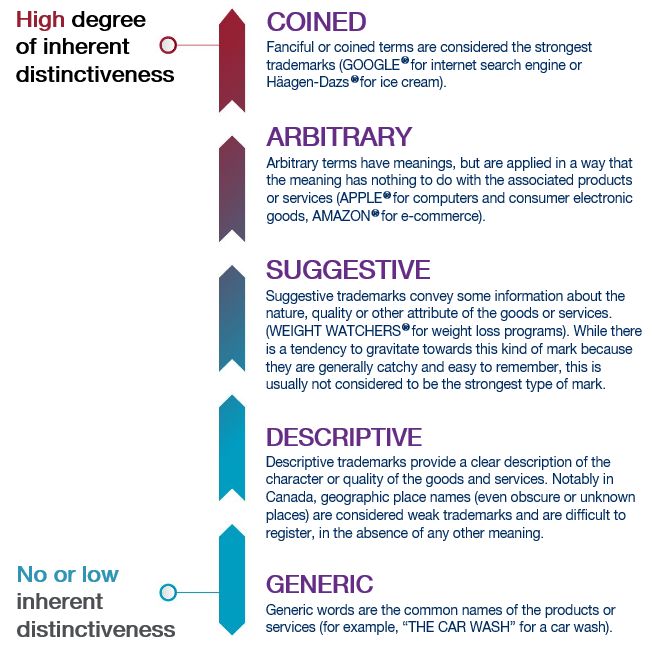The IP Asset is an article series designed to help you enhance your understanding of how intellectual property strategy can positively impact your business.
In this article, we discuss the importance of branding and offer strategic considerations for selecting a strong trademark.
What is a brand?
Your brand is your connection with consumers. A strong brand can help to develop customer loyalty and lets consumers know what to expect out of the company or its products or services, which contribute to a company's goodwill.
Brand benefits
A brand can be one of a company's most important and valuable assets. This is the case for Fortune 500 companies, such as APPLE®, GOOGLE® and AMAZON®, which have some of the world's most valuable brands.1
This is also true for small and medium enterprises (SMEs). Even if a SME will not become a Fortune 500 company, it should not overlook the importance of a brand. After all, a brand is more than just a name; it is part of a company's corporate image, its identity. As a company grows, so too can its reputation. Having a strong trademark and brand can create more opportunities, such as:
- Increased financing (SMEs holding formal IP received 1.4-2.8 times more financing);2
- Driving more demand for a product and obtaining a higher price;
- Other potential income streams, such as licensing;
- Potentially easier expansion into new product or service lines;
- Potentially easier expansion into other jurisdictions; and
- More effective methods to prevent competitors from trying to trade on a company's goodwill (or the goodwill in its products and services) and from confusing consumers.
First step in creating a valuable brand
Selecting a distinctive trademark is a critical first step to developing a strong brand that can bring value to a company. Trying to build a valuable brand around a weak or non-distinctive trademark can be an uphill battle, not to mention a weak ROI in terms of enterprise value.
What makes a strong trademark?
A strong trademark is one that is distinctive of a company or its products or services, and allows consumers to recognize the offering, even in a crowded marketplace. It helps consumers make quicker buying decisions. The more distinctive the trademark is, the stronger, more enforceable, and more likely that the trademark will be registrable.
Spectrum of distinctiveness
The chart below illustrates the spectrum of distinctiveness and relative strength of different categories of trademarks starting with highly distinctive coined terms (at the top) to not inherently distinctive "generic" terms (at the bottom).

What are some strategic considerations for selecting a strong trademark?
A company should consider trademark candidates that are closer to the more inherently distinctive side of the spectrum. Selecting a trademark that is more inherently distinctive can avoid issues that may prevent registration with the Canadian Intellectual Property Office and with other Intellectual Property Offices worldwide. Trademark registration provides some unique enforcement and brand advantages, so selecting a trademark that is more likely to be registrable from the beginning is a key strategic consideration.
Another key step in the trademark selection process is to conduct comprehensive searches of trademark databases and common law (unregistered) rights. This will help avoid selecting a trademark that is already in use by another company, sometimes a competitor, who is using the trademark in a similar way. Selecting the same or a confusingly similar trademark as another party can create confusion in the market and the company that has used the trademark for longer may require a newer company to change its trademark. This can require abandoning a trademark, re-branding, or both, which can be a costly exercise for a SME.
Other key considerations in selecting a trademark may include:
- Domain name availability: is the .com (or other preferred) domain name available?
- Plans to enter foreign markets: does the proposed trademark have an unexpected or secondary phonetic or literal meaning in another language?
- Word and/or logo trademarks: a design/logo trademark usually provides protection only for the specific design and stylized font (if one is used), whereas a word mark usually protects against all stylized forms of the word, providing a broader scope of protection that could continue in the event the logo evolves over time.
- Regulatory considerations: some industries may also have certain brand naming considerations or constraints (i.e. "LASA" test in the case of brands used with pharmaceuticals).
Conclusion
A brand can have great value from a marketing and commercial perspective, as well as from a financial and legal perspective. Strategically selecting a strong trademark is a critical first step in creating and maintaining a valuable brand. A trademark strategist or trademark lawyer can help navigate towards a strong trademark in order to build a brand that will bring value to your company's goodwill.
The IP Asset
This article is part of a thought leadership series called The IP Asset from BLG's Beyond IP Strategy that aims to provide practical insight and information for Canadian companies and their advisors, including startups, scale-ups and established companies with a focus on innovation.
In our previous edition in The IP Asset series, our colleagues discussed why having an IP strategy matters for your company's success.
Watch for our next article in the series, which will explore patent enforcement as a commercial strategy.
Footnotes
1 Best Global Brands 2020, Interbrand
2 IP Canada Report 2019, Innovation, Science and Economic Development Canada (see page 34 Fig 18)
The content of this article is intended to provide a general guide to the subject matter. Specialist advice should be sought about your specific circumstances.


